The Guitar Interview: Behind the scenes in Las Vegas with Aerosmith stars Joe Perry and Brad Whitford
Joe Perry and Brad Whitford know how to put on a show. We head to Las Vegas and go behind the scenes at Aerosmith’s Deuces Are Wild residency to find out what it’s like livin’ on the edge.
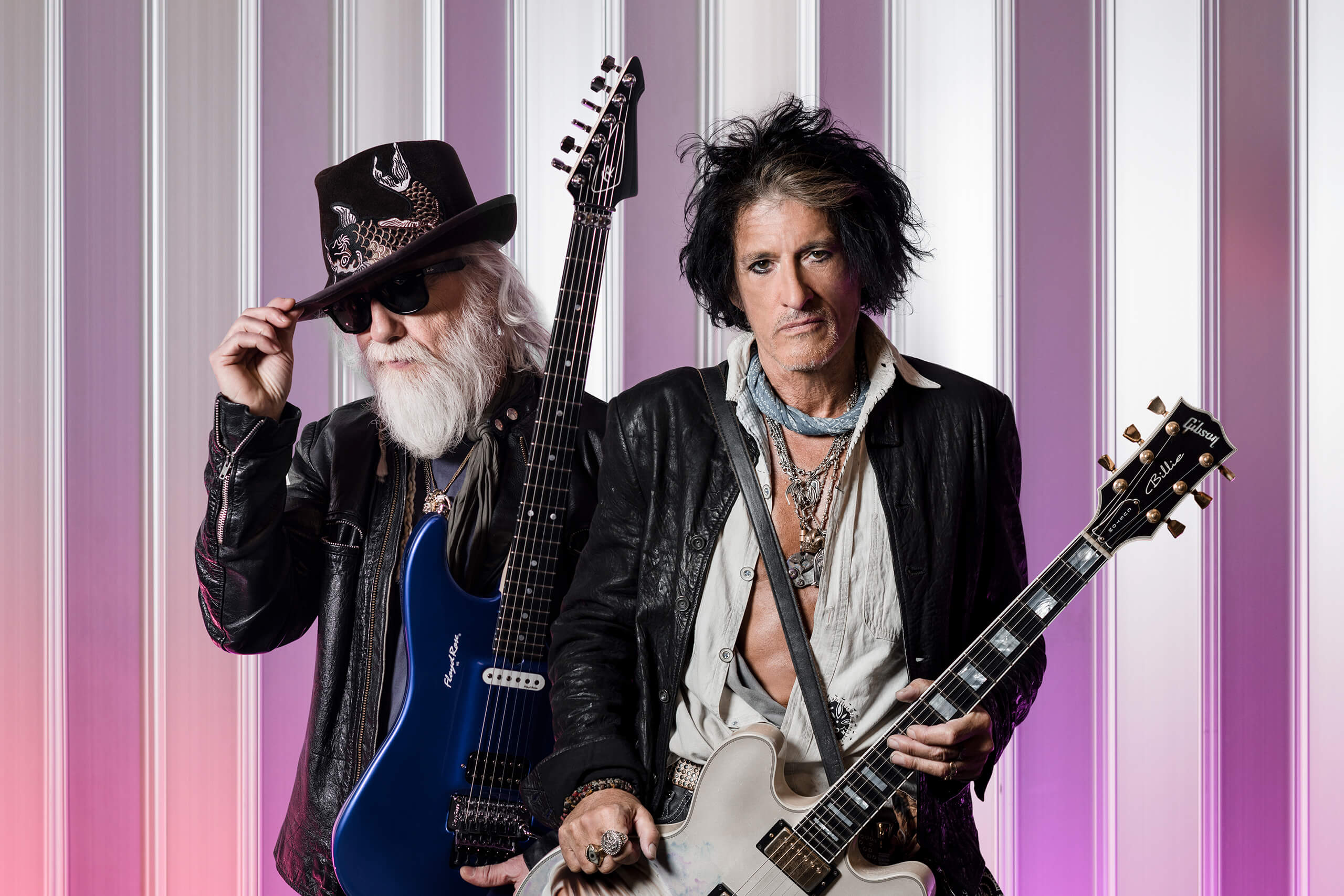
All images: Eleanor Jane
Although it once had a reputation for anything-goes attitudes and X-rated billboards for equally X-rated clubs, today Sin City feels rather more sanitised. On this particular weekend, the Strip is overflowing with families queuing up for candy at M&M’s World, video-game luminaries networking before the DICE Awards, enterprising rappers peddling mixtapes to hapless passers-by, and smiling showgirls offering Kodak moments for a modest fee.
Las Vegas and rock ’n’ roll have much in common – both destination and genre possess a waning notoriety, having reined in their behaviour over the past few decades in favour of safer, more corporate-friendly comportment. Rock music still bares its teeth but, these days, it rarely bites.
It’s fitting, then, that we’re here to see one of the last great rock bands, and find out how Aerosmith’s famed guitar duo view the evolution of the music that’s given them so much over the years.
Rock royalty
We meet Joe Perry in his dressing room at the 5,200-seat Park Theater. It’s a dimly lit, cosy home away from home, with antique rugs hanging on the wall behind the couch and tarnished firearms resting on the coffee table in front of it. Scarves adorn the makeshift apartment’s ebony furnishings, strewn about selectively like snow on a model railway village.
“My thing is, I always follow the singer. He’s leading the charge. Because Steven’s got such great sense of rhythm, I get my tempo from him and not the drummer”
Perry tidies up while Viva Las Vegas emanates from a nearby iPad. He momentarily switches over to Johnny Cash before abandoning the music entirely. “It’s distracting,” he calls out with a grimace, thoughtfully deferring to the nature of our visit.
Reclining with one of the last great guitar gods, the gravity of it all sets in: Joe Perry’s name is synonymous with the instrument itself yet he remains kind, accommodating and illuminating, carefully considering the questions before answering.

Congratulations on 50 years.
“Thanks, it’s a big deal.”
How have the residency shows differed from a normal tour?
“The bottom line is not having to travel from city to city after every show, the wear and tear is a lot less. You get to play on the same stage with the same equipment, same sound system. This venue is probably one of the best in the world.
“It was designed for music, and for entertainment that was based around sound. Basically, they kind of used the [Beatles’] Love show as a blueprint for how to get the best event, so everybody feels like they’re getting the best possible mix. When we heard it was that kind of building, we were excited about doing it.”
How are the fans reacting?
“We’ve heard nothing but good from all the fans. They say they can hear everything and it’s loud but not painful. This place is, I have to say, one of the best indoor venues that we’ve played over all these years.
“I thought I was going to be bored because it’s the same venue but, in fact, it’s been more exciting because every show gets a little bit better, and that goes for everything from production to the lights to the playing. I’ve actually heard everybody’s playing get better over the past 30 shows.”
“The days of the guitar hero are kind of past. It’s like any other instrument, standard operating equipment”
Has it also given you a chance to experiment?
“Oh, always! If you’re a guitar player who’s captivated by the instrument, like I am, you want it to sound good – not only for me but for the house. Here, you can leave everything set up the same and if something’s wrong, you tweak it here, tweak it there. You try and figure out why it was good last night or what went wrong. It’s a process of constantly getting it better.”
Does the intimacy of the venue give you a different dynamic with the fans?
“It’s been great to get a connection with the fans that you don’t normally get in an arena where you rely so much on the video screens and the huge PA systems. I use wedges like the old days and that way I can actually hear the audience shouting shit out. ‘I love that song, I love that fucking hat you wore!’ So there really is an intimacy that I get from playing here.”
How do you respond to that?
“When Elvis was learning to be a performer, he’d do a show at the hayride or at the county fair. He said, ‘I’d wiggle my finger and I’d see a couple of girls scream. I did it again the next night and more girls screamed’.
“That’s one of the things you can do in this venue, as opposed to going from city to city, where you really are playing to a different audience, a different culture. Texas is a different country to Florida, Atlanta and Detroit. Vegas is a big mixing pot, it works just the opposite. Everybody’s getting together from all parts of the world, and they’re at our show because they want to hear a rock ’n’ roll band. I can’t complain about it at all.”

Are you tweaking the setlist every night?
“Sometimes we’ll change the set, other times we’ll leave it the same. Sometimes I’ll throw something in the set without even talking about it, I’ll just start playing the song. I’ll look at Steven and if he feels like doing it, we’ll do it.
“This is a really loose, honest-to-goodness rock ’n’ roll show; this is as close as you’re going to get to being in a rehearsal room with Aerosmith.”
Are you choosing the gear on a song-by-song basis, and are you bringing out old gear you haven’t used in a while?
“I could probably do a show with two or three guitars, but because I’ve got the luxury of bringing my batch of guitars – the one I played on Janie’s Got A Gun, the one I played on Train Kept A-Rollin’ – I can bring that guitar to that song, and it makes it closer to how it should sound.
“Here, because the sound is so good, people can probably hear the difference between two guitars that they may not hear in a stadium, so it’s worth bringing out the good stuff. I try to bring as much of the studio vibe to the stage as I can.”
You seem to have an affinity for upside-down Strats. What’s that about?
“I started doing that in ’79 with a left-handed Telecaster neck on a right-handed guitar. I’m left-handed but I didn’t know any better, so I started playing right-handed guitars.
“There’s definitely something to a left or right-handed Strat played by a guy who’s just the opposite – certain technical things that are really minor but they change the sound. I like the upside-down headstock, where the vibrato is, where the controls are. I played that guitar pretty much through the Joe Perry Project days until the band got back together.
“Over the years I’ve had other ones built for me, such as the Nelson guitars – he’s actually [Stone Temple Pilots bassist] Robert DeLeo’s guitar tech. He built a couple for me and they’ve been my go-to Strats because they’ve got the right size neck and frets.”

You’ve certainly got some other interesting guitars, too.
“I’ve got a friend, Kurt Hendrick, and we built this odd-shaped white guitar that we call Cloud Nine. It’s got some tweaky things that make it unique.”
Like those pickups?
“Seymour Duncan makes these P-Rails pickups that are half P-90 and half single-coil blade pickup, and you can choose what combination you want. I don’t know why they aren’t more popular but you get some really cool sounds out of them. I’ve had them put on at least three or four guitars now.”
You also have quite the pedal-switching set-up on stage.
“I just had Bob Bradshaw build me a whole new rig from the ground up because sometimes I’m over there [gestures to his right] and I want to turn the thing off. With Bob’s rigs you have about three different places you can turn shit on and off from. So I have the pedals in the back all set, and a set-up down at the very end of the stage for wah, another one on my microphone, and [guitar tech] Marco has one in the back. If I put a fuzz tone on and I run over there, he can turn it off.
“Then there’s a couple of secret weapons we built into it. You’ve seen my rig?”
We saw the oscilloscope.
“That’s so I can see where the harmonics are popping in or out, depending on how hard I’m playing.”
So that’s not just for show, you’re working off of that?
“Yeah, I look at it every once in a while to see how the volume is hitting the amps. There’s a two-track recorder in there, some old military equipment that we’ve found to help analyse the sound. I don’t want to explain any more of it – it’s my own thing.”
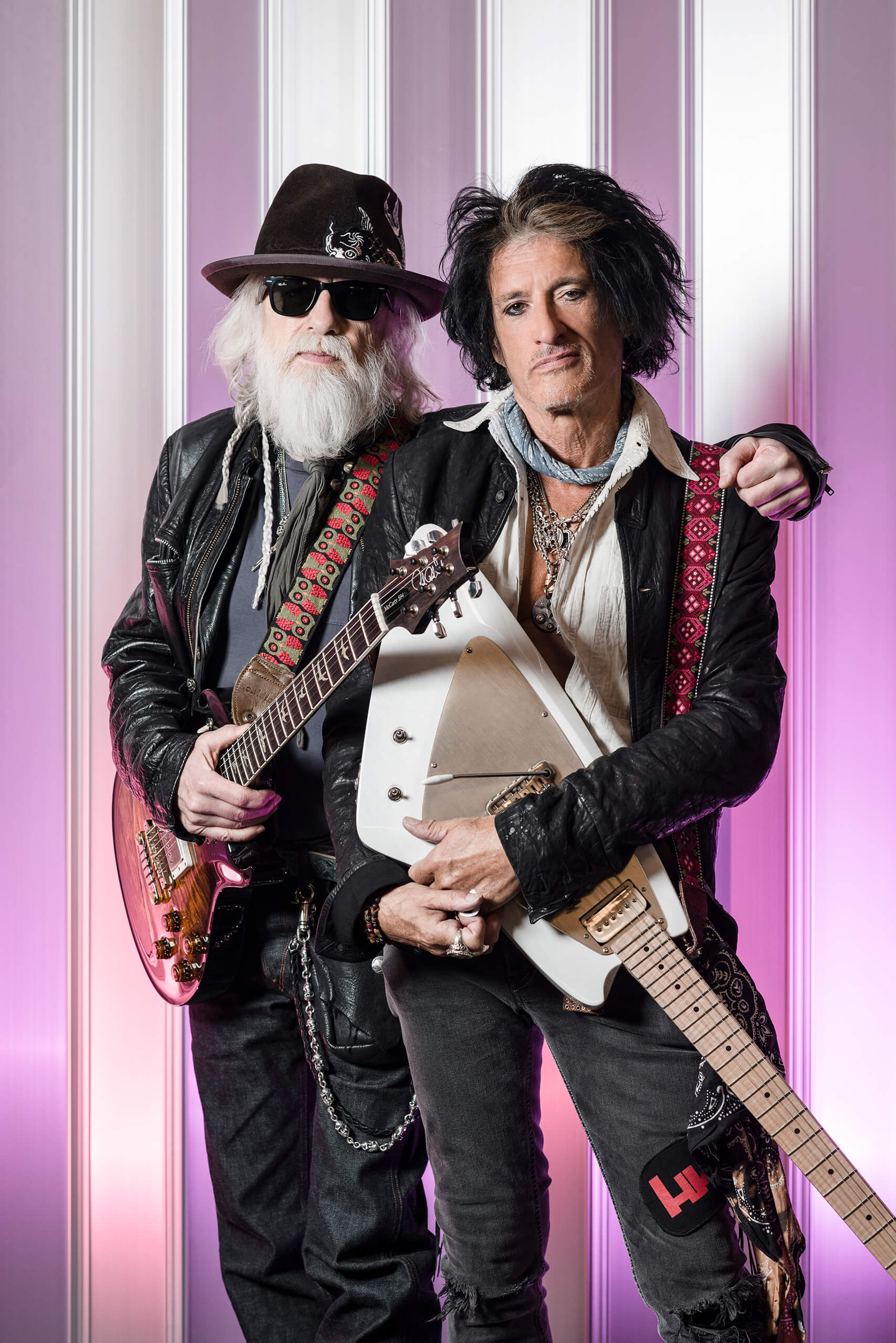
Your secret’s safe with us.
“I could easily do the show with a stack of Marshalls and a wah pedal but, luckily, my hobby and my way of making a living go hand in hand, and I’m able to experiment with this stuff.”
Your lead tone has always stood out. Where other guitarists might go bigger, bolder, more saturation, your sound is often much cleaner. Where does that come from?
“I just want to be heard! To hear the chords chiming. It’s that sort of balance, because Brad uses a little bit more compression and a little bit more cut, and his sound works for the leads and the rhythms he plays.”
Yet your individual sounds seem to work together so well.
“A lot of that is non-verbal. We kind of watch what the other is doing – what he’s using for a rig, what I’m using for a rig. Even in the early days, when we only had a couple of guitars each, if he was using a Strat, I’d use a Gibson. It didn’t make sense for us to both use humbuckers and Marshalls.”

You have one of the most long-standing guitar partnerships in rock. Have your roles shifted at all over the years?
“If anything, our roles have become more defined. But he definitely carries the ball more than people realise. His background is different to mine, he’s a lot more classical so he knows a lot more about music theory. Even if it’s a song I wrote, I would often much rather play the rhythm part and let him play the lead that I played in the studio.”
What about songwriting?
“My thing is, I always follow the singer. He’s leading the charge. Because Steven’s got such great sense of rhythm, I get my tempo from him and not the drummer. He’s spectacularly on-time, so as long as I can hear him, I know where I should be steering things.
“We’re all entertainers, so I want to give him the best bed he can have. Then, when it’s time for me to do a solo, sometimes it’s better to just not. You don’t have to do a solo anymore.”
No more solos? Say it ain’t so…
“The days of the guitar hero are kind of past. It’s like any other instrument, standard operating equipment. Back when we were starting, nobody had guitars that sounded like Zeppelin and the Stones – they were new instruments. All of those guys were experimenting with guitars played through distorted amps, and Hendrix was creating sounds that nobody had ever heard before.
“Back when we were starting, nobody had guitars that sounded like Zeppelin and the Rolling Stones”
“It was a pretty phenomenal instrument when I was growing up. It’s evolved to a point where even the shape of them is iconic around the world. They represent freedom, America.”
What about the state of the guitar in modern music?
“Kids now, they look at it as just one more instrument, one more voice that they can use to write a song and help people grab onto it. They’re coming up with melodies and songs, which is really what it’s all about. There are a lot of other great guitar players out there, people interpreting it from wherever they learned it, whether it’s country or rock, pop, rap, whatever. It’s a very adaptable instrument.
“There was a time when walking around with a guitar case was like walking around with a little baby dog today – it got the chicks to notice you. You might know three chords but that was enough to get a conversation going. Now it’s no big deal.”

Perhaps the dogs are more effective.
“[Laughs] Yeah, things have levelled out. It’s not the same as it was in 1968, when you had Jimmy Page and everyone in the audience was there to hear him.”
Do you think there’s anybody still carrying that torch?
“Jeff Beck. He’s probably the one. He’s still a guitar hero. He’s still making sounds out of that thing that will stand out heads, hands and feet above everybody else – forever. Jeff knows there’s always one more thing he can do, one more thing he could make it sound like, and he’s still doing it today. He’s the fuckin’ shit.
“Me, I’m still out there scruffing it out.”
What ground is there left to cover? What’s next for Aerosmith?
“All I know is that because we’ve had so many generations of fans, a lot of them don’t know the songs from the early days, so I want to bring them back into the set. I don’t see a reason to write a new album when we have five albums from the 1970s that most people don’t know about.
“Those are the songs that influenced Slash, influenced the Foo Fighters, influenced all those bands that come up and say, ‘I picked up the guitar because of Toys In The Attic’. I look at them as brand-new songs. So we’re still fucking around with them.”

Eye of the storm
Compared to Perry’s, Brad Whitford’s dressing room seems spartan. There are, of course, some plush seats in the corner, a table with a stack of Get Your Wings LPs – presumably waiting to be signed – and a sunburst Les Paul laid across the arms of another chair. It’s clear that for Whitford, this is a place of work, not leisure.
Whitford is welcoming and friendly but a commanding presence. Later, when an aide informs us that it’s time to wrap up, he’s reassuring. “Go on, take as much time as you need,” he says. “It’s my call.”
He’s also quite good at navigating an interview. His answers are concise and focused but never dismissive. He knows exactly the point he’s trying to make and, like the consummate guitar master he is, knows when he’s said enough.

Did you ever think it would go on this long when you first joined the band?
“Well, of course.”
Always?
“[Laughing] I mean, no way! Couldn’t imagine it. We came from that era where Mick Jagger was saying, ‘I’ll be doing something else by the time I’m 30’. So there was the sense that maybe we can’t do this forever but, hey, look at Mick!”
How has this residency differed from your usual shows and tours?
“Travel is not an issue. I can walk over here from my room, the show’s over at 10:20pm and I’m back by 10:50pm. So you have a lot more time to do the things you want to do. I’m not a gambler or anything but we have fun here.”

Has it given you the chance to experiment?
“Absolutely. I keep fine-tuning and I mean fine-tuning.”
Incremental.
“You get to listen to your rig so much and I can come over here any time I want to play with it. It’s been a joy.”
Have you pulled out old pieces of gear for these shows?
“I brought a lot of amplifiers with me from home, from storage. I tried out a lot of different stuff before I landed where I am.”
“How do you improve on a Stratocaster, a Les Paul? That doesn’t really happen”
How are the 3 Monkeys and Magnatone heads working out for you?
“They’re fantastic. They’re basically modded Marshall and Fenders, hybrid schematics that have been around for years. The Magnatone is a perfected 50-watter. I’ve combined the 3 Monkeys with a lot of other stuff, sometimes a Marshall or another 3 Monkeys.
“When I’m recording I’ll use the 20-watt Sock Monkey amp. We did a session here with Buck Johnson. I used my Les Pauls and Teles straight into the Sock Monkey – no effects, nothing. People go, ‘How’d you get that sound?’ When it’s naked like that, you can put it right in your face. I love it.”
It seems these days that Joe is gravitating toward a lot of custom builds, whereas you tend to stick with the classics.
“The tools have been there as long as I have. It’s like, how do you improve on a Stratocaster, a Les Paul? That doesn’t really happen. There are a lot of knock-offs but to me you can’t beat them.”
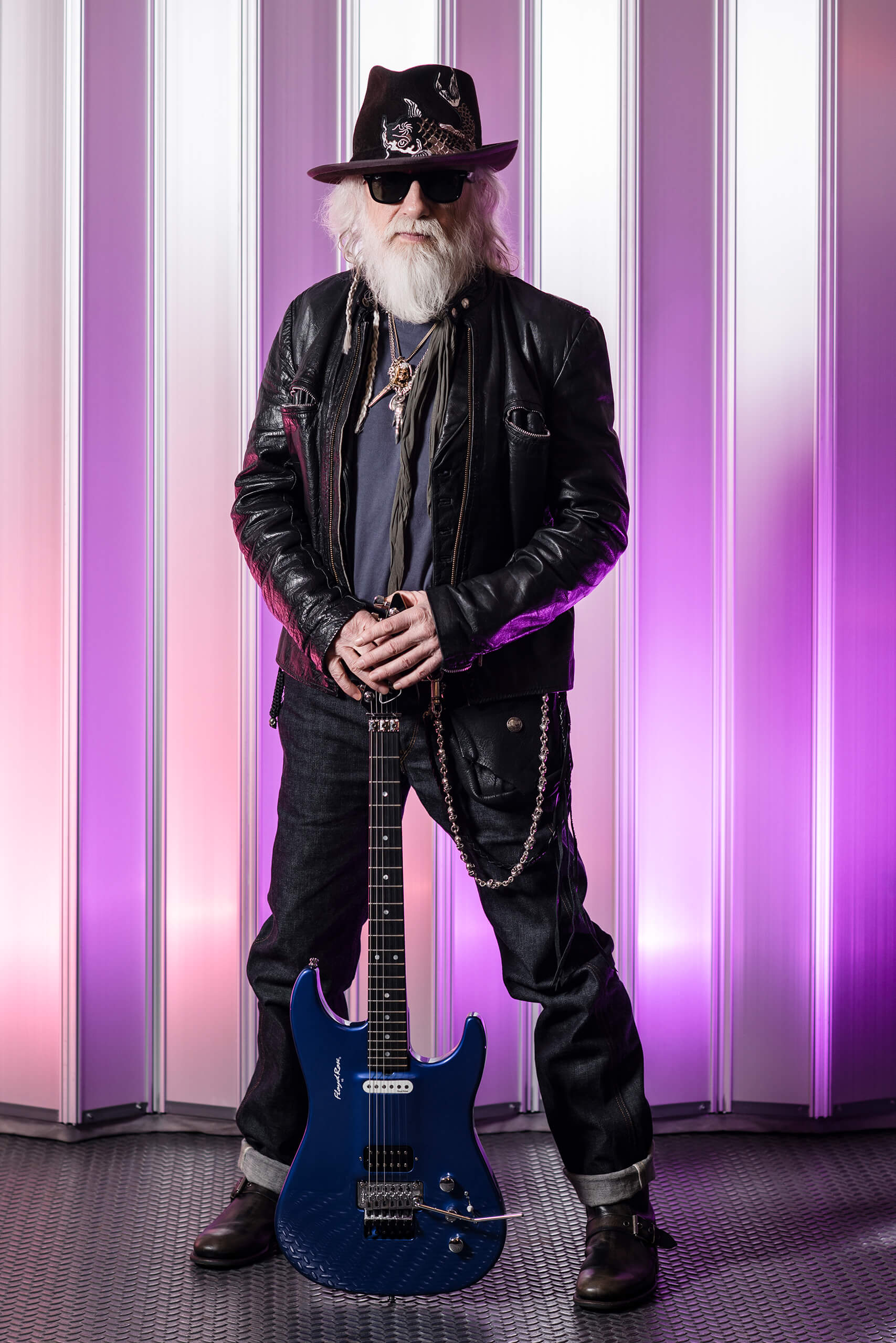
I imagine that at this point you’ve played just about every guitar out there.
“If I go into a music store and play every Strat they have, there’s always one that’ll jump out of the pack. It’s this synergy of the neck wood, the body wood. In some instances they really love each other. I’ve played guitars that might as well be doorstops.”
Is there a certain sound you’re chasing?
“I’m not chasing anything right now, at this point it’s just fine-tuning. I used to have guitars where I’d throw some pickups in, thinking that’ll make it sound better, but if the wood’s not co-operating it doesn’t work. It’s about the wood.
“When you have a good guitar, throw some good-quality pickups in there and it just goes up again. You try and put those pickups in a guitar that’s not up to it, you’re just wasting your time.”
“I like to play a guitar unplugged first – a guitar will tell you things about itself”
So it’s all about the wood, for you?
“Oh yeah, you can feel it in the guitar. I like to play a guitar unplugged first – a guitar will tell you things about itself, how it vibrates, and if it’s not ringing, it’s just not going to ring. You can change pickups, new hardware, but it’s all a waste of time. I found that out the hard way.”
What got you into the guitar in the first place?
“What sent me over the top was the British Invasion. The Beatles were so profound to me and this stuff kept coming from England, which was interesting because so much of it was American blues being re-interpreted. They did it their way. I studied Clapton, I was fascinated by his playing. Jimi Hendrix, Jimmy Page, Jeff Beck, of course.
“There are so few people waving the rock flag now. It’s crazy to me that all the young guys have to go over to Europe to get an audience. Rival Sons is like a treasure to people over there.”
Who else is carrying the torch, in your opinion?
“There are a lot of young guys, I can’t name them all. Rival Sons, Tyler Bryant & The Shakedown – one of the best fuckin’ shows I’ve ever seen. And every time I see them, they’re better than the last time. So there’s hope.”
How has the guitar dynamic between you and Joe shifted over time?
“I’m not in the background as much as I used to be. It’s my opportunity to play, they can try and stop me. If anything, we’ve grown closer as friends. I have the strongest bond with him, rather than anybody else in the band. We speak the same language because we’re guitar players.”
You both complement each other so well, musically speaking. How does that happen?
“It’s organic. It always just happens.”
No discussion?
“Very rarely. In the earlier days I’d say, ‘Oh, he’s playing that Strat, so I’ll play my Les Paul’. Sometimes two of the same guitars together is fine, but it’s always more harmonically complex to have a Les Paul and a Tele or a Strat.”

We were really happy to hear stage volume during soundcheck.
“It’s like it doesn’t exist anymore! I’m not into the Kempers but I appreciate what they do – it’s so great the way this stuff has come along. Def Leppard uses them and the sound is so close to the original records, it’s glorious. I went to see Steve Miller and it’s an absolutely stunning sound up front but then you stand on the side of the stage and there’s nothing. It’s so weird but, boy, it works.
“I think it’s much easier to mix out front if you isolate it but, you know, we’re old-school. It’s about plugging into a good amplifier and going for it. To me, that’s part of what real rock ’n’ roll is – it has to have some chaos to it. It’s always a battle.”
What’s the process of creating the Aerosmith vibe?
“Well, every part of the song has to be a hook. You can’t have any dead spaces. When we were recording, Steven was always pushing us to create something different. Steven studied The Beatles so intensely that he knew what made good songs. He taught me a lot about song construction. He was a perfectionist but it would always turn into quality stuff. It still stands on its own!
“It feels very special to have made a real musical statement in this world, music that millions of people appreciate and listen to. I don’t know what else you can ask for as a musician.”
It seems like Aerosmith never shied away from trying something new.
“It was always very creative in the studio, we were always doing crazy things. We put a big piece of plywood on the floor, Steven put tambourines on his boots, and we recorded it. We used coconuts for the clippity-clop, and Steven did the whip sound from Back In The Saddle with a real whip.”
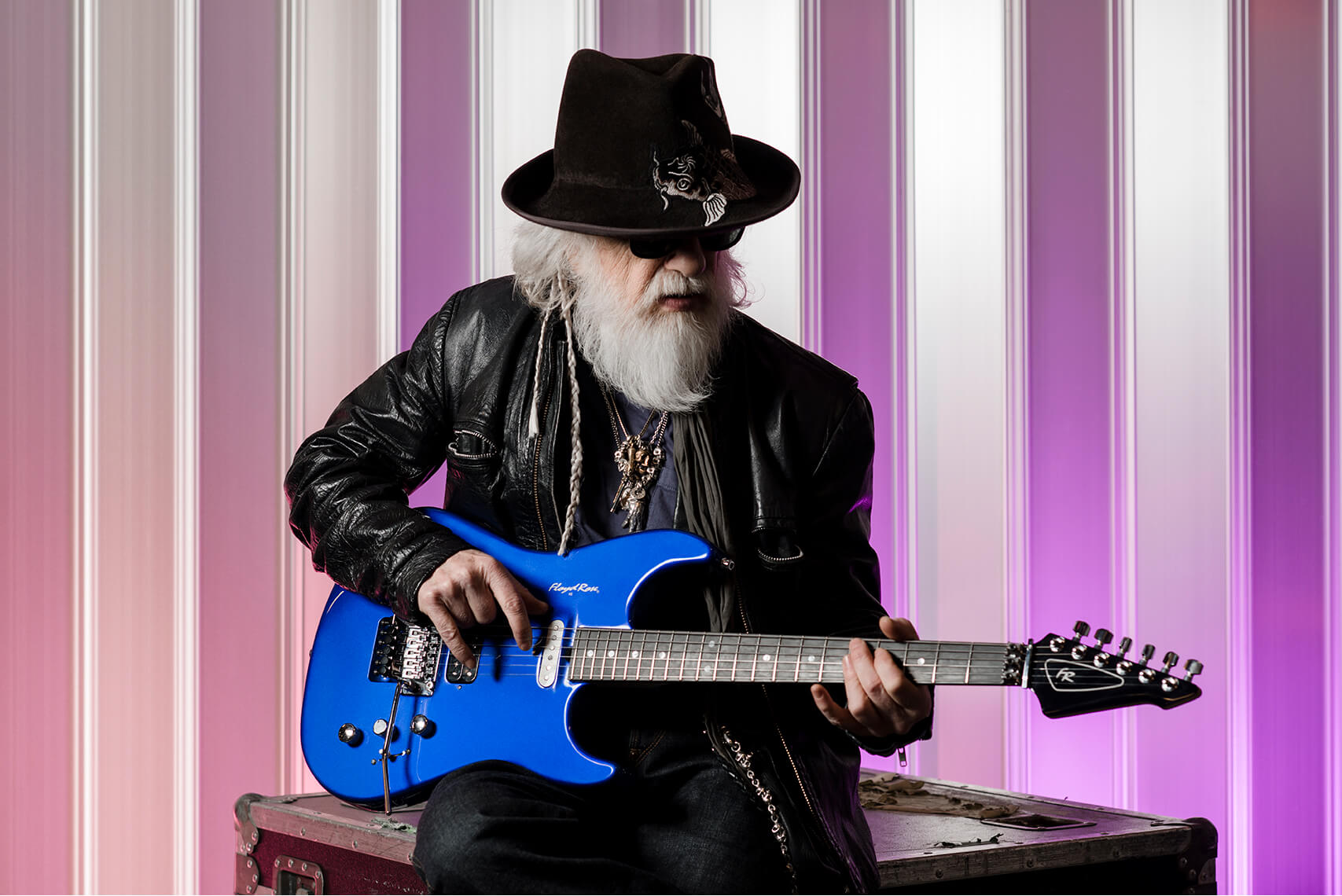
We’d love to see the mic setup.
“[Laughs] I don’t know how we even did that. And [producer] Jack Douglas was always such an inspiration, we called him the sixth member. Always messing around with the tape machine.”
After such a long and prosperous career, what key lessons have you learnt along the way?
“I’ve learnt a lot about how to play the guitar, how the guitar is supposed to work. If you hit it too hard, it sends out a shockwave. I find that the lighter I play, it lets the guitar talk. I had to work on that because when you start getting into something, instead of being loose and free, all of a sudden you’re tight, your whole body tenses up.
“50 years is a lot of wear and tear. Just to still be here is an absolute miracle”
“I had to do a lot of meditation and projection. I picture myself on stage being in a relaxed state. I try to bring that into my playing and it makes all the difference. You can see it in John McLaughlin’s playing – he has this incredible centre. Steve Vai and Eric Johnson are the same way. Just completely effortless, extremely intelligent.”
Is there any ground left for Aerosmith to cover?
“We’ll see. We’ve been doing this a long time and 50 years is a lot of wear and tear. Just to still be here is an absolute miracle. To have the original members too – it’s bizarre.
“There’s lots of stuff I still want to do. I’m experimenting with some other stuff. When I get back to Nashville, I’m getting together with David Santos and Joe Vitale. We’ll see what comes out of that. You never know.”
Show time
After a brief respite and a beverage, we scurry back to the Park MGM Theater to attend a show that begins with a 40-minute acid-tinged retrospective film, replete with career-spanning interviews and performance clips projected across eight enormous screens. Costumed mascots dance across the stage beneath, while a countdown clock tells the already lubricated audience how much time they have left to get a top-up on their beer.
Soon enough, the house lights go down and a grinning Steven Tyler hollers to the crowd, “Sin Citaaaaaaaaay!”
The crowd hollers back.
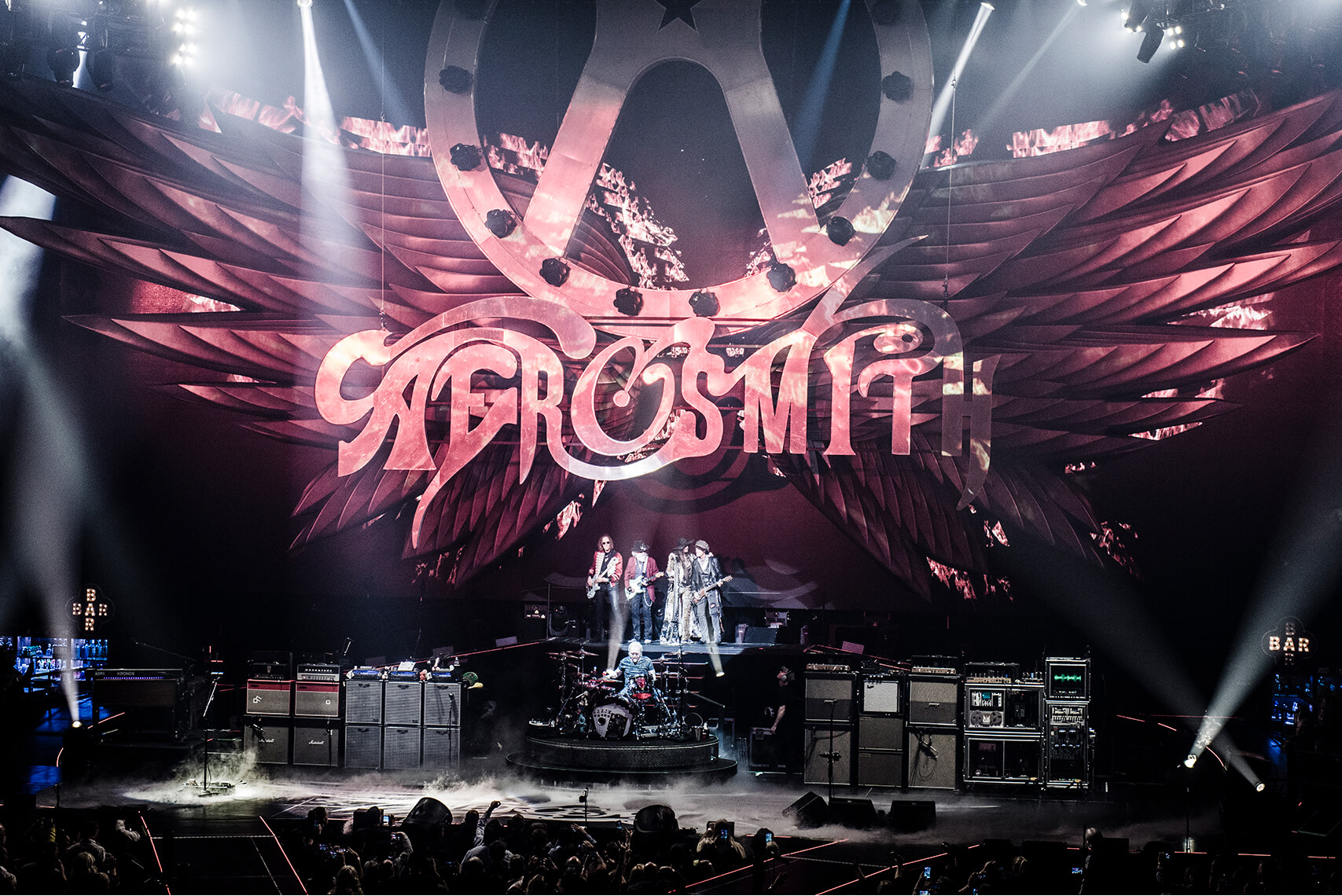
Much later, after a blistering show culminates with a thrilling encore of Dream On, featuring Tyler on a previously concealed piano, the band departs and we follow suit. Patrons buzz about favourite moments from the show as they flood back out onto the casino floor, and many seem to scarcely believe that they witnessed such a satisfying Aerosmith performance in 2020.
Reflecting on the day, it would seem that the guitar isn’t nearly as dead as so many naysayers have recently portended. While it’s no longer the lightning rod it once was, Aerosmith’s six-stringers make a case for its position as a songwriting tool, a method for maximum sonic impact. Perhaps that’s where it truly belongs.
Stay tuned for a full rundown of Brad and Joe’s live rigs on Guitar.com – for more information on the band’s upcoming dates, visit aerosmith.com.
